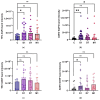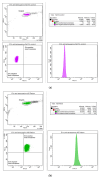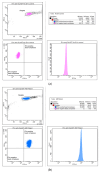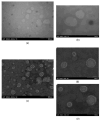Astrocyte Dysfunction Reflected in Ischemia-Induced Astrocyte-Derived Extracellular Vesicles: A Pilot Study on Acute Ischemic Stroke Patients
- PMID: 39596535
- PMCID: PMC11594292
- DOI: 10.3390/ijms252212471
Astrocyte Dysfunction Reflected in Ischemia-Induced Astrocyte-Derived Extracellular Vesicles: A Pilot Study on Acute Ischemic Stroke Patients
Abstract
Extracellular vesicles (EVs) secreted by astrocytes (ADEVs) mediate numerous biological processes, providing insights into damage, repair, and protection following ischemic stroke (IS). This pilot study aimed to broaden the current knowledge on the astrocyte response to ischemia by dynamically assessing the aquaporin-4 (AQP4) and glial cell line-derived neurotrophic factor (GDNF) as cargo proteins of these vesicles in eighteen acute IS patients and nine controls. EV proteins were detected by Western blotting and followed 24 h (D1), 7 days (D7), and one month (M1) after symptoms onset. The post-ischemic ADEV AQP4 and GDNF levels were higher at D1 compared to the control group (p = 0.006 and p = 0.023). Significant differences were observed in ADEV AQP4 during the three evaluated time points (n = 12, p = 0.013) and between D1 and D7 (z = 2.858, p = 0.012), but not in EV GDNF. There was a positive relationship between the severity of stroke at D1 according to the National Institutes of Health Stroke Scale, and ADEV AQP4 at D1 (r = 0.50, p = 0.031), as well as ADEV GDNF at D1 and D7 (r = 0.49, p = 0.035 and r = 0.53, p = 0.021, respectively). The release of EVs with distinct protein profiles can be an attractive platform for the development of biomarkers in IS.
Keywords: Western blotting; acute ischemic stroke; aquaporin-4; astrocyte-derived extracellular vesicles; glial cell line-derived neurotrophic factor.
Conflict of interest statement
The authors declare no conflicts of interest.
Figures







Similar articles
-
GFAP as Astrocyte-Derived Extracellular Vesicle Cargo in Acute Ischemic Stroke Patients-A Pilot Study.Int J Mol Sci. 2024 May 24;25(11):5726. doi: 10.3390/ijms25115726. Int J Mol Sci. 2024. PMID: 38891912 Free PMC article.
-
M2 microglial small extracellular vesicles reduce glial scar formation via the miR-124/STAT3 pathway after ischemic stroke in mice.Theranostics. 2021 Jan 1;11(3):1232-1248. doi: 10.7150/thno.48761. eCollection 2021. Theranostics. 2021. PMID: 33391532 Free PMC article.
-
Astrocyte-Derived Extracellular Vesicles for Ischemic Stroke: Therapeutic Potential and Prospective.Aging Dis. 2024 May 7;15(3):1227-1254. doi: 10.14336/AD.2023.0823-1. Aging Dis. 2024. PMID: 37728588 Free PMC article. Review.
-
Dopamine receptor activation increases glial cell line-derived neurotrophic factor in experimental stroke.Exp Neurol. 2013 Sep;247:202-8. doi: 10.1016/j.expneurol.2013.04.016. Epub 2013 May 9. Exp Neurol. 2013. PMID: 23664961
-
Extracellular Vesicles Derived From Neural Stem Cells, Astrocytes, and Microglia as Therapeutics for Easing TBI-Induced Brain Dysfunction.Stem Cells Transl Med. 2023 Mar 17;12(3):140-153. doi: 10.1093/stcltm/szad004. Stem Cells Transl Med. 2023. PMID: 36847078 Free PMC article. Review.
Cited by
-
Extracellular Vesicle-Associated Angiopoietin-2 and Cell Migration-Inducing Protein in Lung Cancer Progression and Brain Metastases.Cureus. 2025 Mar 7;17(3):e80200. doi: 10.7759/cureus.80200. eCollection 2025 Mar. Cureus. 2025. PMID: 40190907 Free PMC article.
References
-
- Feigin V.L., Stark B.A., Johnson C.O., Roth G.A., Bisignano C., Abady G.G., Abbasifard M., Abbasi-Kangevari M., Abd-Allah F., Abedi V., et al. Global, Regional, and National Burden of Stroke and Its Risk Factors, 1990–2019: A Systematic Analysis for the Global Burden of Disease Study 2019. Lancet Neurol. 2021;20:795–820. doi: 10.1016/S1474-4422(21)00252-0. - DOI - PMC - PubMed
-
- Wechsler L.R., Adeoye O., Alemseged F., Bahr-Hosseini M., Deljkich E., Favilla C., Fisher M., Grotta J., Hill M.D., Kamel H., et al. Most Promising Approaches to Improve Stroke Outcomes: The Stroke Treatment Academic Industry Roundtable XII Workshop. Stroke. 2023;54:3202–3213. doi: 10.1161/STROKEAHA.123.044279. - DOI - PubMed
MeSH terms
Substances
Grants and funding
LinkOut - more resources
Full Text Sources
Medical

